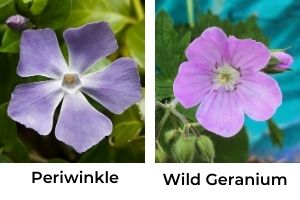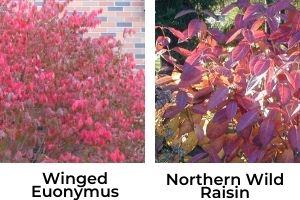Non-native, invasive species are species that do not naturally occur in an area that can proliferate in a new environment quickly and easily. 
- Out-compete native plant species
- Change the composition of the urban forest, limiting essential wildlife habitat
- Reduce biodiversity, as is happening to many of our local ravines
Though the management of invasive species in our parks and natural areas is a complex issue, there is something we can all do to help! We can choose to forgo non-native, invasive species and plant native species in our yards instead! Not only are we helping reduce the spread of invasive species, but we’re also giving local birds, pollinators and other wildlife more access to high-quality food sources and better shelter.
The first step is correctly identifying which plants are non-native, invasive species. This can be a challenge if the information is not readily available. To help, we developed an educational factsheet that identifies commonly planted invasive species and provides a native alternative. Some of the species might surprise you!
Replace periwinkle with wild geranium

Periwinkle (Vinca major, Vinca minor) is popular for its striking blue flowers. Unfortunately, this invasive species can spread to natural areas very easily. What’s more? Their leaves are toxic to many grazers, such as deer. We suggest planting wild geranium (Geranium maculatum) instead. This perennial grows in dense patches and their beautiful pink-lavender flowers bloom in late spring to early summer, attracting the distant miner bee, a local pollinator.
Replace winged euonymus with northern wild raisin

Winged euonymus (Eunonymus alatus), or burning bush, as it’s commonly known for its bright red fall foliage, tolerates a wide variety of growing conditions. Unfortunately, it can also aggressively spread and has been found growing in natural areas where it out-competes local plants, changing the composition of the local ecosystem. We suggest planting northern wild raisin (Viburnum cassinoides) instead. This shrub has a beautiful fall colour that ranges anywhere from orange to a deep purple and it produces an edible fruit that attracts small mammals and local birds, such as robins and cedar waxwings.
Replace Norway maple with sugar maple

By now, many of us are aware that Norway maples (Acer platanoides) are invasive. But, few are aware that the commonly planted maple with purplish/maroon leaves is actually a cultivar of the Norway maple called ‘Crimson King!’ Norway maples spread rapidly and, because their roots are typically closer to the surface of the soil, they tend out-compete native species for water and nutrients which often inhibits the establishment and growth of new plants. We suggest planting sugar maple (Acer saccharum) instead. This hardy tree has a wide canopy that provides excellent shade and displays a bright gradient of fall colour from green to yellow to orange to red. Its dense canopy also provides a home for nesting birds, such as chickadees and woodpeckers.
These are just three of the beautiful native alternatives to commonly planted invasive species. Learn about more in our new factsheet: Plant Native for Backyard Biodiversity: How to improve wildlife habitat in the city.
And, for even more information, consult the Ontario Invasive Plant Council’s Grow Me Instead guide.
When you get to the planting stage, ensure the highest chance of success by planting the right species for you, your property and the wildlife around you! LEAF can help! We offer subsidized tree and shrub planting services which include a consultation with a certified arborist. We also offer a variety of native shrubs and garden kits that make creating wildlife habitat easy!
Daniela Serodio is the Marketing and Communications Manager at LEAF.
The #BackyardBiodiversity campaign is a partnership initiative with the Toronto Wildlife Centre and is supported by Ontario Power Generation.
The Backyard Tree Planting Program is supported by the City of Toronto, the Regional Municipality of York, Durham Region, the City of Markham, the Town of Newmarket, the Town of Ajax, the City of Oshawa, the City of Pickering, the Township of Scugog, the Town of Whitby and Ontario Power Generation.
